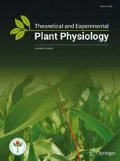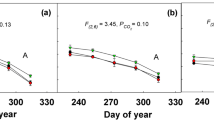Abstract
Environmental stressors increase methane (CH4) emissions from plants. Few studies have investigated the interactive effects of multiple abiotic factors on CH4 emissions from plant vegetative organs and almost none from reproductive organs. We examined the combined effects of temperature, ultraviolet-B radiation, and watering regime on aerobic CH4 emissions from plant reproductive parts. Pea (Pisum sativum L. cv. 237J Sundance) plants were grown under two temperature regimes (22/18 °C and 28/24 °C; 16 h light/8 h dark), two levels of UVB radiation (0 and 5 kJ m− 2 day− 1), and two watering regimes (field capacity and wilting point) in controlled-environment growth chambers for over a month, after one week of initial growth under 22/18 oC. Then, CH4 emissions were measured from fully-opened flowers and pods (1-, 5-, and 10-day-old). Higher temperatures decreased flower dry mass, but significantly increased CH4 emissions from flowers. Other individual environmental factors did not affect flower and pod dry mass or CH4 emission. In some cases, however, interactions between or among factors significantly affected pod dry mass and CH4 emissions from flowers and pods, suggesting the synergistic effects of environmental factors on plant-derived CH4. In conclusion, stress factors increased flower and pod CH4 emissions, which had inverse relationships with dry mass of reproductive organs.





Similar content being viewed by others
References
Abdulmajeed AM, Abo Gamar MI, Qaderi MM (2018) Inter- and intra-varietal variation in aerobic methane emissions from environmentally stressed pea plants. Botany 96:837–850
Abdulmajeed AM, Qaderi MM (2017) Intrashoot variation in aerobic methane emissions from pea plants exposed to multiple abiotic stresses. Acta Physiol Plant 39:124,1–16
Abdulmajeed AM, Qaderi MM (2019) Differential effects of environmental stressors on physiological processes and methane emissions of pea (Pisum sativum) plants at various growth stages. Plant Physiol Biochem 139:715–723
Andrady A, Aucamp PJ, Austin AT, Bais AF, Ballaré CL, Barnes PW, Bernhard GH, Björn LO, Bornman JF, Congdon N, Cory RM, Flint SD, de Gruijl FR, Häder D-P, Heikkilä A, Hylander S, Longstreth J, Lucas RM, Madronich S, McKenzie RL, Neale P, Neale R, Norval M, Pandey KK, Paul N, Rautio M, Redhwi HH, Robinson SA, Rose KC, Solomon KR, Sulzberger B, Wängberg S-Å, Williamson CE, Wilson SR, Worrest RC, Young AR, Zepp RG (2017) Environmental effects of ozone depletion and its interactions with climate change: progress report, 2016. Photochem Photobiol Sci 16:107–145
Angadi SV, Cutforth HW, Miller PR, McConkey BG, Entz MH, Brandt SA, Volkmar KM (2000) Response of three Brassica species to high temperature stress during reproductive growth. Can J Plant Sci 80:693–701
Bruhn D, Møller IM, Mikkelsen TN, Ambus P (2012) Terrestrial plant methane production and emission. Physiol Plant 144:201–209
Bueckert RA, Wagenhoffer S, Hnatowich G, Warkentin TD (2015) Effect of heat and precipitation on pea yield and reproductive performance in the field. Can J Plant Sci 95:629–639
Chavana UD, Shahidi F, Bal AK, McKenzie DB (1999) Physico-chemical properties and nutrient composition of beach pea (Lathyrus maritimus L.). Food Chem 66:43–50
de Sousa-Majer MJ, Turner NC, Hardie DC, Morton RL, Lamont B, Higgins TJV (2004) Response to water deficit and high temperature of transgenic peas (Pisum sativum L.) containing a seed-specific α-amylase inhibitor and the subsequent effects on pea weevil (Bruchus pisorum L.) survival. J Exp Bot 55:497–505
Devasirvatham V, Gaur PM, Mallikarjuna N, Tokachichu RN, Trethowan RM, Tan DKY (2012) Effect of high temperature on the reproductive development of chickpea genotypes under controlled environments. Funct Plant Biol 39:1009–1018
Dueck TA, de Visser R, Poorter H, Persijn S, Gorissen A, de Visser W, Schapendonk A, Verhagen J, Snel J, Harren FJM, Ngai AKY, Verstappen F, Bouwmeester H, Voesenek LACJ, van der Werf A (2007) No evidence for substantial aerobic CH4 emissions by terrestrial plants: a 13C-labelling approach. New Phytol 175:29–35
Grover A, Sinha SK (1985) Senescence of detached leaves in pigeon pea and chick pea: regulation by developing pods. Physiol Plant 65:503–507
Guilioni L, Wery J, Tardieu F (1997) Heat stress-induced abortion of buds and flowers in pea: is sensitivity linked to organ age or to relations between reproductive organs? Ann Bot 80:159–168
Hatfield JL, Prueger JH (2015) Temperature extremes: effect on plant growth and development. Weather Clim Extrem 10:4–10
Hedhly A, Hormaza JI, Herrero M (2008) Global warming and sexual plant reproduction. Trends Plant Sci 14:30–36
Jeuffroy MH, Duthion C, Meynard JM, Pigeaire A (1990) Effect of a short period of high day temperatures during flowering on the seed number per pod of pea (Pisum sativum L.). Agronomie 10:139–145
Jiang Y, Lahlali R, Karunakaran C, Kumar S, Davis AR, Bueckert RA (2015) Seed set, pollen morphology and pollen surface composition response to heat stress in field pea. Plant Cell Environ 38:2387–2397
Keppler F, Hamilton JTG, Braß M, Röckmann T (2006) Methane emissions from terrestrial plants under aerobic conditions. Nature 439:187–191
Konsens I, Ofir M, Kigel J (1991) The effect of temperature on the production and abscission of flowers and pods in snap bean (Phaseolus vulgaris L.). Ann Bot 67:391–399
Koti S, Reddy KR, Reddy VR, Kakani VG, Zhao D (2005) Interactive effects of carbon dioxide, temperature, and ultraviolet-B radiation on soybean (Glycine max L.) flower and pollen morphology, pollen production, germination, and tube lengths. J Exp Bot 56:725–736
Liu J, Chen H, Zhu Q, Shen Y, Wang X, Wang M, Peng C (2015) A novel pathway of direct methane production and emission by eukaryotes including plants, animals and fungi: an overview. Atmos Environ 115:26–35
Martel AB, Qaderi MM (2017) Light quality and quantity regulate aerobic methane emissions from plants. Physiol Plant 159:313–328
Martel AB, Qaderi MM (2019) Unravelling the effects of blue light on aerobic methane emissions from canola. J Plant Physiol 233:12–19
McLeod AR, Fry SC, Loake GJ, Messenger DJ, Reay DS, Smith KA, Yun B-W (2008) Ultraviolet radiation drives methane emissions from terrestrial plant pectins. New Phytol 180:124–132
Minitab Inc (2014) Minitab Release 17: statistical software for windows. Minitab Inc., State College
Petkova V, Nikolova V, Kalapchieva SH, Stoeva V, Topalova E, Angelova S (2009) Physiological response and pollen viability of Pisum sativum genotypes under high temperature influence. ISHS Acta Hortic 830:665–672
Qaderi MM, Reid DM (2005) Growth and physiological responses of canola (Brassica napus) to UV-B and CO2 under controlled environment conditions. Physiol Plant 125:247–259
Qaderi MM, Reid DM (2009) Methane emissions from six crop species exposed to three components of global climate change: temperature, ultraviolet-B radiation and water stress. Physiol Plant 137:139–147
Qaderi MM, Reid DM (2011) Stressed crops emit more methane despite the mitigating effects of elevated carbon dioxide. Funct Plant Biol 38:97–105
Qaderi MM, Reid DM (2014) Aerobic methane emissions from stinkweed (Thlaspi arvense) capsules. Plant Signal Behav 9:10
Qaderi MM, Basraon NK, Chinnappa CC, Reid DM (2010) Combined effects of temperature, ultraviolet-B radiation, and watering regime on growth and physiological processes in canola (Brassica napus) seedlings. Int J Plant Sci 171:466–481
Ravishankara AR, Daniel JS, Portmann RW (2009) Nitrous oxide (N2O): the dominant ozone-depleting substance emitted in the 21st century. Science 326:123–125
Reay D, Smith P, van Amstel A (eds.) (2010) Methane and climate change. Earthscan Ltd, London, p 261
Reddy AR, Viswanatha Chaitanya KV, Vivekanandan M (2004) Drought-induced responses of photosynthesis and antioxidant metabolism in higher plants. J Plant Physiol 161:1189–1202
Rodiño AP, Hernández-Nistal J, Hermida M, Santalla M, De Ron AM (2009) Sources of variation for sustainable field pea breeding. Euphytica 166:95–107
Sampson BJ, Cane JH (1999) Impact of enhanced ultraviolet-B radiation on flower, pollen, and nectar production. Am J Bot 86:108–114
Stocker TF, Qin D, Plattner G-K, Tignor M, Allen SK, Boschung J, Nauels A, Xia Y, Bex V, Midgley PM (eds.) (2013) Climate change 2013: the physical science basis. Contribution of working Group I to the fifth assessment report of the intergovernmental panel on climate change. Cambridge University Press, Cambridge, p 1535
Tevini M, Teramura AH (1989) UV-B effects on terrestrial plants. Photochem Photobiol 50:479–487
Tomás-Barberán FA, García-Grau MM, Tomás-Lorente F (1991) Flavonoid concentration changes in maturing broad bean pods. J Agric Food Chem 39:255–258
Van Amstel A (2012) Methane. a review. J Integr Environ Sci 9:5–30
Vigano I, van Weelden H, Holzinger R, Keppler F, McLeod A, Röckmann T (2008) Effect of UV radiation and temperature on the emission of methane from plant biomass and structural components. Biogeosciences 5:937–947
Warrag MOA, Hall AE (1983) Reproductive responses of cowpea to heat stress: genotypic differences in tolerance to heat at flowering. Crop Sci 23:1088–1092
Zioni AB, Vaadia Y, Lips SH (1971) Nitrate uptake by root as regulated by nitrate reduction products of the shoot. Physiol Plant 24:288–290
Acknowledgements
We acknowledge Natural Sciences and Engineering Research Council (NSERC) of Canada for financial support through a Discovery grant and Mount Saint Vincent University for a Standard Internal Research grant to MMQ. A graduate scholarship from Saudi Cultural Bureau to AMA is greatly acknowledged. We appreciate the useful comments on the manuscript from an Associate Editor and an anonymous referee.
Author information
Authors and Affiliations
Corresponding author
Additional information
Publisher's Note
Springer Nature remains neutral with regard to jurisdictional claims in published maps and institutional affiliations.
Rights and permissions
About this article
Cite this article
Abdulmajeed, A.M., Qaderi, M.M. Methane emissions from reproductive organs of pea plants exposed to multiple abiotic factors. Theor. Exp. Plant Physiol. 32, 79–87 (2020). https://doi.org/10.1007/s40626-020-00170-1
Received:
Accepted:
Published:
Issue Date:
DOI: https://doi.org/10.1007/s40626-020-00170-1




